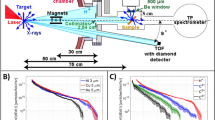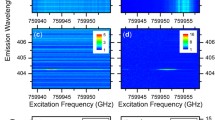Abstract
A new multi-element analysis technique based on laser-excited atomic fluorescence was reviewed. However, the one-wavelength-one-transition constraint was overcome. Numerous elements were induced to fluoresce at a single excitation wavelength of 193 nm. This was possible provided that the analytes were imbedded in dense plumes, such as those produced by pulsed laser ablation. The underlying mechanism of the technique was explained and corroborated. Analytical applications to metals, plastics, ceramics and their composites were discribed. Detection limits in the ng/g range and mass limits of atto moles were demonstrated. Several real-world problems, including the analysis of paint coating for trace lead, the non-destructive analysis of potteries and ink, the chemical profiling of electrode-plastic interfaces, and the analysis of ingestible lead colloids were discussed.
Similar content being viewed by others
References and notes
R. Noll, Laser-Induced Breakdown Spectroscopy: Fundamentals and Applications, Berlin Heidelberg: Springer, 2012
N. H. Cheung, Resonance-Enhanced LIBS, in: Laser Induced Breakdown Spectroscopy: Fundamentals and Applications, edited by A. Miziolek, V. Palleschi, and I. Schechter, London: Cambridge University Press, 2006
D. J. Butcher, Appl. Spectrosc. Rev., 2005, 40(2): 147
S. K. Ho and N. H. Cheung, Anal. Chem., 2005, 77(1): 193
S. K. Ho and N. H. Cheung, Appl. Phys. Lett., 2005, 87(26): 264104
S. K. Ho and N. H. Cheung, J. Anal. At. Spectrom., 2007, 22(3): 292
S. K. Lau and N. H. Cheung, Appl. Spectrosc., 2009, 63(7): 835
P. C. Chu, W. L. Yip, Y. Cai, and N. H. Cheung, J. Anal. At. Spectrom., 2011, 26(6): 1210
N. H. Cheung, Appl. Spectrosc. Rev., 2007, 42(3): 235
Y. Cai and N. H. Cheung, Microchem. J., 2011, 97(2): 109
S. K. Ho, Highly Sensitive Elemental Analysis of ArF Laser Excited Atomic Fluorescence of Laser Plumes, Thesis for the Degree of Doctor of Philosophy, Hong Kong Baptist University, 2007
A. Beiser, Concepts of Modern Physics, 6th Ed., New York: McGraw Hill, 2003
H. Bach and D. Krause (Eds.), Analysis of the Composition and Structure of Glass and Glass Ceramics, Berlin: Springer, 1999
C. Pan, Yixing Pottery: The World of Chinese Tea Culture, especially Ch. 9, San Francisco: Long River Press, 2004
J. C. J. Bart, Plastics Additives: Advanced Industrial Analysis, especially Ch. 3, Amsterdam: IOS Press, 2006
Consumer Product Safety Improvement Act 2008, US Product Safety Commission, test method CPSC-CH-E1003-09
M. N. Gernandt and J. J. Urlaub, J. Forensic Sci., 1996, 41: 530
F. C. Kreb and K. Norrman, Prog. Photovoltaics: Res. Appl., 2007, 15: 697
S. T. Lee, Z. Q. Cao, and L. S. Hung, Appl. Phys. Lett., 1999, 75(10): 1404
S. J. Jo, C. S. Kim, J. B. Kim, S. Y. Ryu, J. H. Noh, H. K. Baik, Y. S. Kim, and S. J. Lee, J. Appl. Phys., 2008, 103(11): 114502
L. Kirste, K. Kohler, M. Maier, M. Kinzer, M. Maier, and J. Wagner, J. Mater. Sci.: Mater. Electron., 2008, 19(S1): S176
N. Bityurin and A. Malyshev, J. Appl. Phys., 2002, 92(1): 605
For a comparison of the analytical performance of PLEAF against ICP-MS, see: S. K. Lau, Minimally Destructive and Multi-element Analysis of Stainless Steel by ArF Laser-Induced Plume Emissions, Thesis for the Degree of Master of Philosophy, Section 2.4, Hong Kong Baptist University, 2012
J. Pisonero, J. Koch, M. Wälle, W. Hartung, N. D. Spencer, and D. Günther, Anal. Chem., 2007, 79(6): 2325
Author information
Authors and Affiliations
Corresponding author
Rights and permissions
About this article
Cite this article
Cai, Y., Chu, PC., Ho, S.K. et al. Multi-element analysis by ArF laser excited atomic fluorescence of laser ablated plumes: Mechanism and applications. Front. Phys. 7, 670–678 (2012). https://doi.org/10.1007/s11467-012-0264-x
Received:
Accepted:
Published:
Issue Date:
DOI: https://doi.org/10.1007/s11467-012-0264-x




